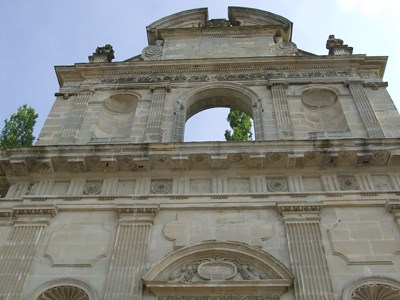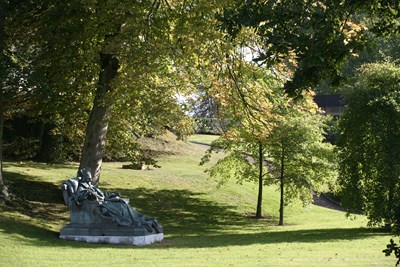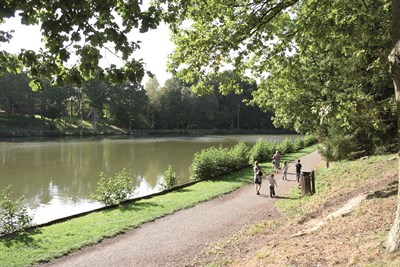Forges-Les-Eaux, its patrimony
Halle Baltard
Pavillon dit Baltard, whose original architecture evokes the famous halls of Paris built by Baltard.
Victor Baltard, born in Paris on June 10, 1805 and died in Paris on January 13, 1874, is a French architect who practiced in Paris under the Second Empire. It is particularly famous for the Halles de Paris which it carried out between 1852 and 1872. These were demolished in 1972-73 with the exception of one of the pavilions (the "Baltard Pavilion") which was classified monument Historical and was moved back to Nogent-sur-Marne. He was responsible for the restoration of several churches and several burials.
The architect (name unknown) who worked at Forges, was inspired largely by his colleague and the fashion of the time. It was essentially the market place for pigs or calves. It was closed on these four sides in the 1970s to serve as a warehouse for a local company. Today only the still visible metallic structure is reminiscent of XIXth century architecture. It hosts part of the market on Sunday morning and the Christmas market the second weekend of December since 1999.
Municipal Theater
Municipal Theater of Forges-les-EauxThe public building was built in 1913 in red and painted brick.
This establishment has served for many years as a show venue, popular balls, theater, and concert.
After the Second World War, it had to be restored and nowadays it is used occasionally by the local associations for various animations.
The interior, with its balcony and its stage, retains a certain antiquated charm..
Museum of the Resistance
Forges-les-Eaux Resistance Museum Situated in a former 19th-century post house, the Museum of Resistance and Deportation presents a superb collection of local objects and testimonies. The local resistance facts, the parachutes of British airmen, the intervention of inhabitants brayons to help the parachutists ... are related there as well as the way of life of the brayons at that time.
Forges-les-Eaux was occupied by the German army during these years and housed the offices of the German kommandantur in the Hotel Continental, the thermal establishment and the casino were transformed into ammunition depot.
The city was liberated on August 31, 1944 by the Canadians. Every year, on this date, the city celebrates this event.
City Hall
The town of Forges-les-Eaux has a partially historic town hall.
In the 17th century, the original building was owned by the Levaillant family, which welcomed King Louis XIII, Queen Anne of Austria and Cardinal Richelieu during their stay in 1633.
Renowned for its ferruginous waters, which were said to cure anemia and sterility, the queen, who could not give an heir to the kingdom, decided to come and enjoy the benefits of the springs.
Forges-en-Bray (name of the town at that time) was not the place of a seigniory, there was no castle to accommodate the royal guests.
It was therefore the most beautiful house in Forges that was requisitioned: that of Monsieur Levaillant, Master glassmaker of his state.
This cure had a beneficial effect on the health of the famous curists since a few years later, Anne of Austria brought into the world Louis XIV and the city became "Forges-les-Eaux" by royal decree.
.jpg)
In the 19th century, the building was owned by Jules Thiessé (1833-1912), deputy, descendant of Levaillant.
He demolished and rebuilt the area along the Place Brévière. Only the Oratory of Anne of Austria and the Guards Corps on the park side were preserved. At his death, the house was bequeathed to the University of Paris.
In 1933, after expropriation, the town recovered the house and made it the town hall of the municipality, replacing the town hall which was hitherto located at the site of the current post. Several transformations were carried out, including the plating of the white facade on the city side to mark the town hall of the other buildings in the square, the construction of the clocheton with the clock, the coat of arms of the town representing the hammer and the anvil.
On the city side, the white facade is characteristic of this period year 30 and side park, the XIXth and the XVIIth are side by side.
City Hall Parc
After passing under the porch of the town hall, one discovers the park of the Town hall, also called Parc Mondory. A pleasant wooded area around a central fountain.
Anne of Austria Pavilion and Guard House
On each side of the town hall there are two vestiges of the 17th century Levaillant house.
On the right, you can discover the elegant oratory of Anne of Austria and just opposite, the body of Garde where were quartered the Musketeers of the King in 1633.
These two buildings evoke the building materials used in the region at that time:
At the bottom of the house several rows of sandstones were arranged to protect the house from the humidity of the soil (the word "Bray" means old French mud).
Then with the wood of the forest of Bray, the frame in half-timbering was arranged more or less fanciful according to the finances of the owner.
The latter was lined with brick that had been made in the Pays de Bray for centuries thanks to the clay present in the basement.
The middle part and the right wing are from the XIXth to the time of the reconstruction of the Deputy Thiessé.
On the occasion of the royal stay, a theater was installed in the garden of the Levaillant house, in which the actor Mondory played the plays of the young Rouen writer Pierre Corneille. Thus the talent of the young author was noticed by Cardinal Richelieu. In memory the park bears the name of the famous comedian who contributed to the revelation of Corneille.
The Cellar
At the end of the park, on the left, you will find a wine cellar that houses a long-pressed press of the XVII-XVIII century (not to be visited). This building was bought from a nearby farm in the late 1980s and rebuilt in this area to house the wine press that was acquired at the same time.
The small bronze statue is a gift from an artist from Battice (Belgium) to celebrate the anniversary of the twinning Forges / Battice which dates from 1961.
Faience Collection
.jpg)
On the first floor of the town hall, in the superb marriage hall, you will discover the very beautiful collection of earthenware from Forges-les-Eaux called "Vieux Forges" (visit only by appointment from Tuesday to Friday at the Office de Tourism).
For centuries, coarse pottery was made in many parts of the Pays de Bray. Its woods, its clay, its springs which are visible on the ground, have always given ceramists potters enough to exercise their art since the Gallo-Roman period.
Many of the earthenware factories in northern France had become accustomed to supplying themselves in the Forges-les-Eaux region.
It was in 1797 that an Englishman named Georges Wood founded the first earthenware factory in Forges-les-Eaux. He had learned his craft as a ceramist in Douai and Chantilly.
The production forgionne was popular. It responded to the tastes and expectations of a clientele that went from the petty bourgeoisie to the most beautiful dishes, to the peasant brayons who came to buy the everyday dishes on the markets.
There are thus two categories of earthenware: the fine earthenware (called Terre de pipe) and the thick earthenware called black bottles (stanniferous faience).
Fine earthenware
This was made with white clay, a creamy white called "pipe earth" because this clay was also used for the manufacture of pipes.
The pieces are generally made with the mold and the decorations with the brush and the sponge. The edges are often surrounded by a black line of manganese. The sponge is used as decoration on marl or to imitate the foliage of trees. This sponge decoration is one of the specialties of Forges.
Thick earthenware
This style of faience, called "black ass", is made with gray clay.
They are called black asses because the undersides of the pieces were covered with a dark brown enamel which was obtained using manganese oxide, used for its robustness and the low cost price. They are cracked. .jpg)
The more refined fine earthenware was rather intended for a wealthy clientele, while the thicker, coarse earthenware found its outlets among the more modest inhabitants.
Up to 5 factories were counted in Forges-les-Eaux all located Avenue des Sources, the last ceased its activity in 1890.
Only today remains at No. 27 Avenue des Sources, one of Georges Wood's earthenware buildings, transformed into private dwelling.
After the cessation of activity, almost all the factories, factories ... were destroyed to make room for new constructions.
The different showcases exposed allow to appreciate a beautiful insight of the richness of these faiences, their specificity.
Museum of the models
The building that houses this museum is composed of an old part (left): old stable of the house Levaillant and a recent part which sheltered the museum of the Resistance.
In the 1970s, Monsieur and Madame Guyot, ironmongers in the Paris region, settled in Forges-les-Eaux for their retirement.
Quickly, to take care of, they will realize during the 16 years of their retirement more than a hundred models with materials of recovery, representing all the trades of our campaigns of the XIXème century to the Fifties.
These models are superbly enhanced in the museum by the wall panels that represent Norman landscapes creating a unique and surprising place. These paintings are the work of Mr. Alemani. Most of the landscapes, villages or houses represented are inspired by the Pays de Bray.
Place Brévière
Main square of the town around which shops, cafes, restaurants animate the city center. It was initially occupied by a church dedicated to Saint Nicolas and a cemetery from the XIIth century.
This edifice sacked during the Revolution remained for a long time in ruins before being demolished in 1824.
After the arrival of Louis XIII in 1633, this place was first baptized Place Royale in memory.
After the disappearance of the church of Saint Nicholas, it became Place du Marché and then the Place de la Halle after the building of a butter hall destroyed in 1946.
Finally it became Place Brévière during the inauguration of the Bust of the engraver in 1873, bust which was requisitioned by the Germans in 1942 to be melted.
Today this square is still dedicated to Louis Henri Brévière. Born in Forges-les-Eaux in December 1797 in the Rue des Fées, this man renovated the woodcut in France, was appointed director of the printing works of the Nationale. He died almost ruined in the south of France in 1869.
His bronze bust stands proudly at the bottom of the square. It is the work of the sculptor Besus, inaugurated in 1993.
Every year on the 1st Sunday of October, the town celebrates Brévière, become municipal festival.
Fairies' Street
In this street is the birthplace of Louis Henri Breviere, home of Father Uger (no. ... of the street).
It is one of the oldest houses in the town of Forges-les-Eaux, originally built of ferruginous sandstone, mud and with thatched roof. A beautiful commemorative earthenware plaque, made by the potter Alexandre Audel, is displayed on the façade.
This street was to lead to mysterious woods inhabited by fairies. The legend tells that during a party one of them incited a certain Uger to dance and to thank him offered to him a bottle of cider. It would never be empty as long as it kept the secret. But Uger finally revealed the secret of the divine bottle and it remained empty forever !
Abbé Féret Street
At n ° 9 of the street of the abbe Féret, one discovers a very beautiful building of the XVIIth century. It would be the former rectory of the commune.
These materials are typical of the architecture of this period: use of sandstone in the lower part to protect against moisture (let us not forget that the word "Bray" in old French means "mud"), structure in half-timber Of the forest of Bray) and then use of the brick.
This street owes its name to the loan that is at the initiative of the construction of the present church in the nineteenth century.
République Street
Called Grande Rue until 1902, there are beautiful restored half-timbered facades dating from the 18th century, built with local materials: sandstone, wood and brick. Originally the roofs were thatched. It was banned after a fire in the 17th century which devastated much of the city, then replaced by the tile and then the slate in the 19th century..jpg)
The large white building, the school of the Sacred Heart at n ° 17 was founded in 1826 at the initiative of Mme de Caulaincourt whose husband was a politician of the 1st Empire, faithful to Napoleon Bonaparte. A very young widow, she devoted her property to donations and charitable works. She founded this school for the instruction of young girls, who became the school of the Sacred Heart.
It is still a private mixed primary school whose inner courtyard offers a magnificent view of the forged countryside (visible only when the porch is open). A plaque on the front relates the creation of this school by Mme de Caulaincourt
Torquesne Street
Certainly one of the oldest streets of Forges-les-Eaux. Its name comes from the fact that at the time of the Gauls this street led to the forest of Bray, which was at the gates of Forges, and in which the Druids celebrated their worship to the God Thor, god of the thunder often represented by an oak (Etymologically "the Thor oak").
Today, small low houses originally built of mud are reminiscent of the antiquity of this street.
Place du Général de Gaulle
Named the Place Verte, Place de l'Eglise, it is dedicated today to General de Gaulle in memory of his passage in our commune in October 1944, after the liberation of Normandy.

At the bottom of this square stands the church of Saint Eloi. At the beginning of the XIXth century, the second church of Forges was built on this square, quickly built to replace the church of Saint Nicholas in Place Brèvière. This building had many defects and had to be shaved quickly.
This church was replaced by the present church at the end of the 19th century.
The monument to the dead, located in the center of the square, was built in 1921, surrounded by 4 shells it represents a hairy wounded sat on the ground. On one side of the monument are the arms of the city, a flag and the following inscription: To his glorious dead the City of Forges.
Church of Saint Eloi
It is the 4th place of Christian worship built by the Forgions.
Chapel Saint Eloi: the first known place of worship in the commune was located at No. 35 Rue de la République. Today there are some iron-sanded sandstone walls in the cellars of the house.
Saint Eloi is the patron of the goldsmiths but also of all the workers making use of the hammer. Since the activity at Forges was mainly linked to the extraction and processing of iron ore, it is not surprising that Saint Eloi was chosen as patron saint of the city.
The first real church was built in the 12th century at the present Brévière square. Dedicated to Saint Nicholas, it was of Romanesque style and surrounded by a cemetery. It was partly rebuilt in the 16th century. It was completely demolished in 1824. Today on this square, nothing remains of this edifice.
The second church was erected quickly and cheaply on the upper part of the current General de Gaulle square. Misdemeanors led to lengthy trials, then the demolition of the establishment.
The present church was built from 1876 to 1878, it is brick and stone neogothic style with an axial and frontal bell tower. The bright interior is not lacking in harmony and majesty. Its stained-glass windows, arranged in an instructive way, represent scenes from the Old and New Testaments.
A small book "The Saint Eloi Church of Forges-les-Eaux 1878 1978" published in 1978 offers a broad description of the building (available at the Tourist Office).
The Beaufils House
Located at 11 Avenue des Sources, at the end of a stone-paved walkway, this superb villa was owned by Mr and Mrs Beaufils, notary of Forges-les-Eaux. This house was surrounded by a park and a lake that has disappeared. The walkway allows to go to the municipal camping passing near the retirement home of Forges les Eaux: the foundation Beaufils. The Beaufils were friends with the Flaubert family.
.JPG)
Flaubert, his mother and little Caroline (niece of Flaubert) decide to leave their property Croisset and take refuge with their friends of Forges. It is in fact mainly for family reasons that the Flaubert Family arrives in Forges. The father of little Caroline (her mother, also named Caroline, sister of Gustave, died in childbirth), Emile Hamard who had fled abroad after the death of his wife. Unstable psychologically, he wants to recover his daughter. Hence the need to leave Croisset, waiting for a legal solution.Taking advantage of his stay in the region, Flaubert will find inspiration for one of his most famous novels: Madame Bovary.
The Avenue of Sources
The avenue of the sources was successively called Allée des Capucins, Rue Royale, Rue des Fontaines, Rue des Eaux Minéraux and finally Avenue des Sources.
Until the 17th-18th centuries, the town of Forges stopped at the level of the present church. Some dwellings bordered this dirt road, which allowed access to the ferruginous waters located in the countryside at the bottom of the town. This alley was lined with trees and served as a walk.
The plan of Forges represented by the engraving of the collection Gaignières of 1696 (National Library) allows us to see what the plan of the city looked like at that time with 3 large spaces.
-The center of the village.
-The Convent of the Capuchins and its large park.
-The lower part of the city with its ferruginous waters.
In fact, between No. 22 and 32 of this avenue, was the Convent of the Capuchins. It was the Duke of Longueville, Governor of Normandy, who, between 1630 and 1631, offered these lands to a community of Capuchin monks so that it could establish permanently in Forges and thus offer drinkers of water passage a place Of prayers. A chapel, conventual buildings and a large park were thus laid out.
For several years, this establishment was the inescapable place of Forges-les-Eaux. The curists went there to pray, to converse in the large garden and especially to attend the rejoicings proposed by the monks: games, spectacle, theater, ball.
Sacrified to the French Revolution, it was sold as national property in 1791, sheltered the gendarmerie from 1793 then in 1826 Madame de Caulaincourt wanted to make it an establishment for the people destined to the priesthood. It was finally a school where the brothers of the Christian schools will give free instruction to the children of the country. From this past there are still large buildings made of red brick from the school of the brothers, the facade on which are two niches sheltering two religious statues and the plaque commemorating the benefactress Madame de Caulaincourt.
Bridge of Charleval
.jpg)
This line of Charleval was set up to serve the valley of the Andelle. It served Forges-les-Eaux / Serqueux at Charleval in the Eure. It was a single-track line with 9 stations, including Forges-les-Eaux, called Forges Thermal by its proximity to the thermal establishment. It was operational at the beginning of the 20th century. It allowed to transport the milk, apples, wood ... It was not profitable, it was closed to the public in 1938, knew again some activities during the Second World War. It was definitively closed in 1969.
Today this old line has been transformed into a walkway linking Forges-les-Eaux to Dieppe, it is a European project called "Avenue Verte" whose final objective is to link London to Paris on foot, By bike and rollerblading.
The bridge of Charleval, double vault in brick, allows the crossing of the Avenue of Sources.
Porte de Gisors
This majestic facade located near the Casino comes from the town of Gisors in the Eure.
Originally, it was the facade of the chapel of the Carmelite convent built in the 17th century in Gisors. The building was built at the initiative of François Sublet, minister of Louis XIII for his daughter who entered the orders.
After the French Revolution, this building was transformed into a municipal theater and bombed during the Second World War.
Jacques Hébertot, owner of the Casino de Forges in the 1950s, bought the last vestige still intact from the town of Gisors and erected it in the town of Forges-les-Eaux in order to recreate a certain historical setting. This is also the case for the facade which is currently located in the park of the municipal swimming pool. Unfortunately, the origin of this facade is more uncertain, it is said to come from a hunting lodge that belonged to Madame de Maintenon without any certainty.
Hotel Continental
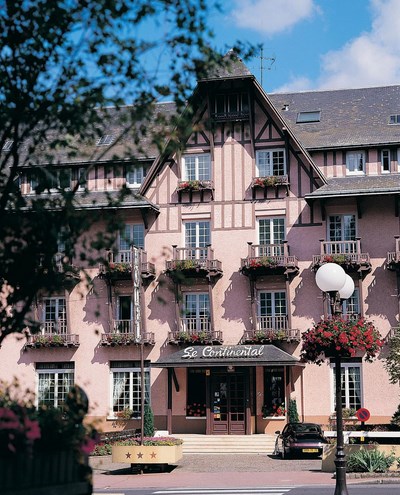
This is the oldest hotel in Forges-les-Eaux built in the 1870s.
At the time, it was one of the most modern buildings in the city, equipped with hot water and gas-fired electricity on all floors.
Its chalet-like architecture evokes the buildings that developed in the water cities at the end of the 19th century or the resort architecture is taking off.
During the First World War, when the city was requisitioned by the Red Cross and transformed into a hospital city, it housed a Franco-English hospital, and during the Second World War, the German army installed the offices of the German Kommandantur.
Villa Richelieu
This pretty villa in brick and wood painted in pastel colors bears the name of Villa Richelieu.
It is a pavilion that was built in Paris in 1867 for the Universal Exhibition. It was the Swiss pavilion.
At the end of the exhibition, this building, completely demountable like all the exhibition pavilions, was offered to the city of Forges-les-Eaux in anticipation of a stay of the Empress Eugénie, wife of Napoleon III.
Ironically, the proximity of the statue of Cardinal Richelieu caused it to be given some time later, the name of Villa Richelieu!
Statue of Cardinal Richelieu
This bronze statue of Cardinal Richelieu welcomes us at the entrance of Forges-les-Eaux at the foot of the Casino. It is the work of the sculptor Hippolyte Lefèvre. It is the property of the Sorbonne, lent to the city.
This sculpture thus evokes the arrival of Cardinal Richelieu in our commune in June 1633 accompanying King Louis XIII and Queen Anne of Austria.
Armand Jean du Plessis de Richelieu, Cardinal-Duke of Richelieu and Duke of Fronsac, born on September 9, 1585 in Paris and died on December 4, 1642 in this same city, is a French ecclesiastic and statesman, peer of France and Chief minister of King Louis XIII.
Originally destined for the weapons trade, he was obliged to return to orders in order to preserve for his family the benefit of the bishopric of Luzon. Temporarily minister of foreign affairs in 1616, he was cardinal in 1622 and chief minister of Louis XIII in 1624. He remained in office until his death in 1642; Cardinal Mazarin succeeded him.
Casino et ancien parc thermal
This lower part of Forges is commonly called "old thermal district".
The casino: The very first casino was built at the beginning of the XIXth century. In 1872 this establishment was razed to build a better equipped and meeting the expectations of the customers of the time.
Unfortunately this magnificent building, which can be seen on old postcards, was destroyed by a fire in 1896.
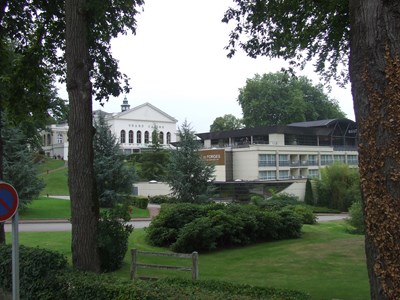
Today, it belongs to the group Partouche and is one of the top 15 casinos in France, famous for its slot machines and traditional games.
As regards the first thermal establishment, it appears rather late. Indeed until then, the station worked with a simple refreshment bar, an open-air basin divided into 3 compartments: Reinette, Royale, Cardinale ... The waters were deemed to be beneficial in absorption only.
The first settlement was built in the 1840s. It was destroyed in 1872 and a more modern building, with quality services, was renovated. It is this building that will be occupied during World War II and unfortunately sacked. He was shaved at the liberation and replaced by a kiosk. This solution, originally temporary, will last until the end of the spa.
This kiosk always visible in the park of the Casino with these blue tiles, was nicknamed during its construction the 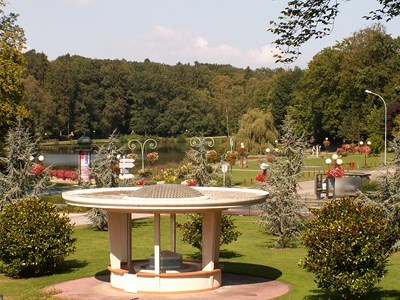 flying saucer. After the war and until the early 1980s, it was around this rotunda that the curists came to drink the Reinette, the Royale and the Cardinale.
flying saucer. After the war and until the early 1980s, it was around this rotunda that the curists came to drink the Reinette, the Royale and the Cardinale.
Today the taps are closed. Forges-les-Eaux is no longer classified as Thermal Resort.
Close to the kiosk and the statue of Cardinal Richelieu, there is a wrought iron gate that frames a staircase. It allows access to the three underground basins of La Reinette, the Royale and the Cardinale (closed to the public). The springs still flow today, they will throw themselves into the river Andelle at the exit of Forges-les-Eaux but are no longer used in any way whatsoever.
The hotel "Forges Hôtel", built in the 1990s (Club Med originally) in the Casino Park, is now a 3-star fitness center (Domaine de Forges / Groupe Partouche).
Statue des trois sources
This pretty bronze fountain represents three statues of identical women. It was created by the artist Normand Jean Marc de Pas on the occasion of the passage to the year 2000. It symbolizes the three ferruginous sources of Forges: the Reinette, the Royale and the Cardinale.
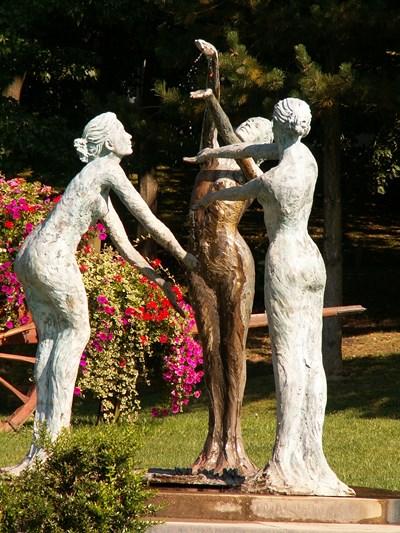
The villas
These elegant villas built near the Casino date from the late 19th century to the beginning of the 20th century. They are a superb example of the resort architecture that develops at this time in the water towns.
Originally built to be rented to spa-goers in resort, they quickly become permanent dwellings.
These cottages use the materials of fashion of this time which thanks to the industrial development and to the railway are accessible and affordable: bricks, metal, canopies ...
A walk along rue Hébertot and rue Cyprien Riden allows you to discover its originality and richness of style.
Other superb examples are visible Lemarié, Godouet, Marette and Beaufils streets: they date from the beginning of the XXème and were destined to be occupied all the year and not to the hiring. They were often built by the middle-class bourgeoisie who lived off their rents.
Manor of the Epinay
This magnificent building located at the entrance of Forges, at the corner of Avenue des Sources and Avenue Mathilde dates from 1863, a style mix between the English manor and the Swiss chalet. It was the property of the Montalent Family, and was used as a reception site, especially during the great hunting season, when it was located in the heart of the Bois de l'Epinay.
Today, this building whose structure has been vastly modified compared to the original, belongs to the Domaine de Forges.
Bois de l'Epinay et lacs
This area, facing the Casino, is one of the main attractions of the city.
Developed between two rivers, the Andelle to the east and the chevrette to the west, the Bois de l'Epinay offers a great diversity of natural environment and covers an area of about 75 hectares.
The species are very varied but some parts show a strong degradation due to their overexploitation in the 19th century by brickworks, forges and faience works.
The ponds are not natural, they were built on old bogs in the 1980s, thus making the space more welcoming.
Today protected and classified sensitive natural space of the Department, this place offers 4 nice walks open to the public (ecological and forest walks):
-The Mirror with birds (550m) allows to walk along the 1st pond. It is a wetland where the vegetation is chosen to contribute to the consolidation of the banks with a landscaping of the basin.
-Wild ponds (450 meters): created in 1989 on a peat marsh, they are staggered on two levels and separated by earth dykes. Fueled by the Andelle river which takes its source upstream in the wood. Wilderness development contributing to the nesting of birds and ducks. The walk runs along one side only.
-La Hêtraie (1,250 meters): this walk allows to discover the wooded part of the Bois de l'Epinay. The large presence of birch is due to the fact that after the exploitation of this space by the man for the forges, the brickworks, the faïenceries ... only this essence knew to recolonize this environment naturally.
-La Chevrette (850 meters): The source is materialized in the wood by a small wooden hut, arrangement already present in the XIXth century. A kiosk was also present at that time, since disappeared. To understand the originality of this source of the herd, it is necessary to know that there are approximately 130 million years deposited in a shallow sea of sand and iron coming from the dismantling of the continental granitic massifs. These formations, exposed to erosion, are traversed by rain water and the multiple subterranean rusts it generates. This dissolves and entrains the ferric oxides contained in the sands. In this slightly acid water, the iron remains in suspension, which explains this curious color that one discovers throughout the course.
La Chevrette then throws itself into the pond of Epinay, open to fishing.
Memory stele
By taking the way from the Gîte Relais du Chasse tide to La Ferté St Samson, you will pass in front of a stele. Stop for a moment and think about them, they were only 20 years old for the most part.
.jpg)
From the investigation of the alleged crash sites, the hearing of different persons and the information and documents provided by the son of M CAMP, the Forges-les-Eaux Resistance Museum was able to reconstruct History of the Halifax and its crew.
.jpg)
On April 18, 1944 at 21:16, the Halifax MK III, HD-R, No. LV 956 of the 466th squadron of the RAAF (Royal Australian Air Force) took off from Leconfield (Yorkshire). Its mission: to bombard the railway installations of Tergnier (N of Soissons).
The route goes over Dieppe, Londinières, Grandvilliers, Vic-sur-Aisne and then Tergnier. The return passes by the overflight of Roye, Conty, Poix-de-Picardie, Aumale and Dieppe.
It is important to point out this route because we note that for the return of the mission, which had happened without incident, the aircraft took a route further south than the planned route and it is for this reason that, He was taken under fire from the German flak and night hunting at the NE of Rouen..jpg)
After being hit by the flak (DCA) and the shots of Oblt Martin DREWES III / NJG 1 (night hunt) in several places (rear and bomb bay), the bomber catches fire immediately. The CASEY pilot, and the 2 SWAN and LYALL gunners are killed by the explosions of the shells. All the intercom system is destroyed, the front burns and the plane begins to prick. It was about 4000 feet (1300m) that the 4 survivors were able to leave the aircraft, it was about midnight, and the four crewmembers found themselves scattered after the jump and each attempted to head towards The SOUTH to regain Spain and then England, with more or less success.
They were instructed to remain hidden at least 24 hours before starting any walk. CAMP and WALLACE were able to return to England. WEIZEMAN and RICHARDS were less fortunate and were taken prisoners a few hours later and then transferred to a prisoner of war camp in Germany.
For more information do not hesitate to visit the Museum of Resistance and Deportation - Rue du Maréchal Leclerc 76440 FORGES LES EAUX - 02 35 90 64 07 (from 14h to 18h).
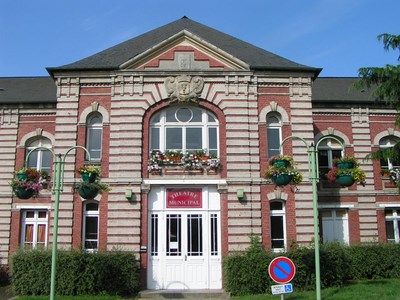
.JPG)
.JPG)
.JPG)
.JPG)
.JPG)
.JPG)
.JPG)
.JPG)
.JPG)
